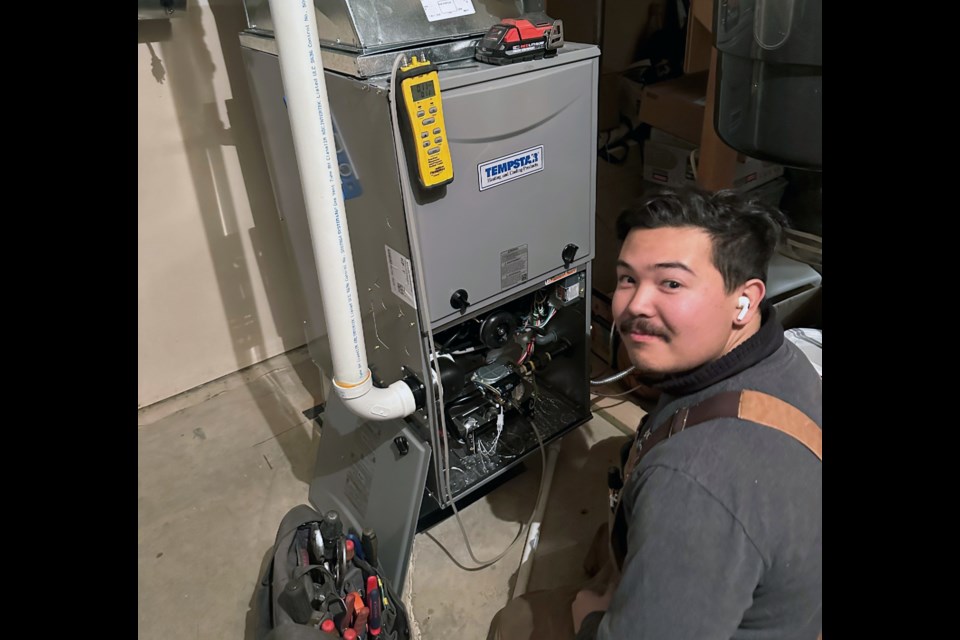Winter is always a busy time for plumbing and heating businesses across north-central 小蓝视频 and heating expert Al Russell knows how vital it is for homeowners and businesses to have heat sources, especially during weather like the recent cold snap felt across Western Canada.
On days when it’s -39 C, as it was Friday morning in Prince George, having a furnace or electric heat pump in working order is essential to prevent water pipes from freezing and keep people and pets comfortable indoors.
Russell owns Buckhorn Heating & Air Conditioning and Carrier Plumbing and Heating in Prince George and he and his staff are working overtime to meet the demand for their services, typical for this time of year and especially true when it’s cold and people have to crank up the thermostat to get through winter.
Russell has noticed a bit of a downward trend for customers choosing to replace their older natural gas furnaces with higher-efficiency models. The reason for that, he says, is the province stopped issuing grants that used to provide homeowners up $950 for a new natural gas furnace. That subsidy ended Dec. 31.
“They’re pushing everybody towards electric, so they stopped giving grants for gas furnaces, even though up north here it very much needs to be gas,” said Russell. “They were getting up to $950 from Fortis and now they get zero so that makes a huge difference in people’s choice to maybe update before it breaks. So they just hang on to their old stuff longer, which is inefficient. I haven’t really got a feel how it’s affected us yet but I’m sure it will.”
Heat pumps use outside air to heat a refrigerant that gets compressed using electricity and that creates hotter air that gets distributed around the house through ducts. Heat pumps are designed for colder weather but not when the outside temperature falls below -30 C, so an alternate heat source is required, either electric furnace/baseboards or a natural gas furnace.
“They’re trying to push people towards heat pumps when they’re already saying limit your use of electricity because of the low water levels,” said Russell. “They’re kind of contradicting themselves. We’re going to do heat pumps because that’s what the government wants us to do, but they’re running out of power. A heat pump is crazy for Prince George. We can’t use just a heat pump, it won’t work.”
Heat pumps are designed to move transfer air from one area to another. In heating mode the unit absorbs heat from outside air, even in cold temperatures, and moves it into the house. In summer it pushes heat out of the house and replaces it with cooler air. The pump uses refrigerant-filled coils to collect heat from the outside air, which is warmer than the coils and that heated air is drawn into the house.
In temperatures below freezing, Russell says heat pumps lose their energy efficiency because the outside air condenses on the coils and that moisture forms frost or ice which eventually blocks air flow going back into the house. To get rid of the frost, the backup heating system (electric or gas) is activated to flip the refrigerant flow into defrost mode and it draws heat from a furnace inside the house to melt the frost to eliminate the blockage. That takes about five or 10 minutes and then the unit switches back to heating mode.
“That’s really inefficient,” said Russell. “The colder it gets, the worse it gets. You can run these things down to really low temperatures but why would you when it’s going to cost you double the money to do that. That’s why I say heat pumps don’t work in the north. They will work in lower temperatures but you’re going to pay for it.”
He said it also takes longer to heat a home with heat pump than it does with a natural gas furnace.
Russell says the natural gas bill for a year to heat a small house might cost roughly $1,000, while a heat pump backed by a natural gas furnace would cost a homeowner around $2,000. If the heat pump is backed by an electric furnace he estimates the annual energy cost would be closer to $2,500, while being solely dependent on an electric furnace would bring that yearly heating bill closer to $3,000.
He said the cost of a high-efficiency cold weather heat pump for home use ranges from $8,000- $20,000, plus the cost of a furnace needed as a backup for the system. A high-efficiency natural gas furnace costs between $5,000 and 7,000. Heat pump rebates are available which pay as much as $5,000, but it’s still more expensive than a natural gas system.
“It’s the cost to run them, that’s the problem,” said Russell.




